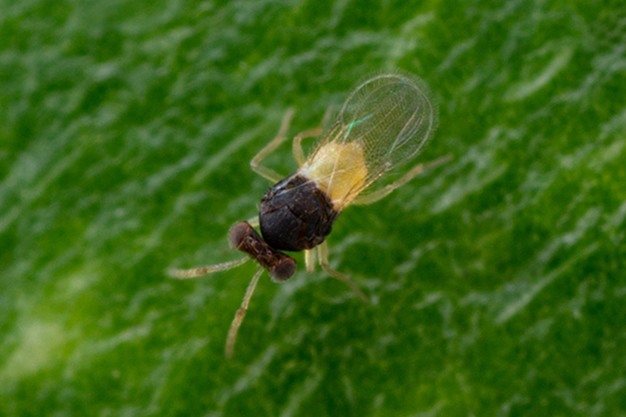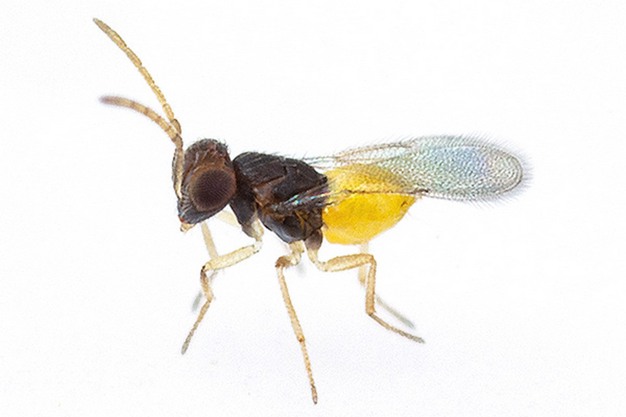A natural predator of the greenhouse whitefly (Trialeurodes vaporariorum), this tiny but efficient parasitoid wasp Encarsia Formosa has become an important tool in integrated pest management, particularly in controlled environments such as greenhouses and nurseries.
How it all started
Dr. Omid Joharchi of Anatis Bioprotection shares that it was first discovered in 1926, when an English tomato grower observed peculiar black pupae among the whitefly population. Encarsia formosa soon became a central figure in biological pest control. “This observation led to the wasp’s commercial use in the UK the following year, marking the beginning of its global journey as a biological agent in the fight against whiteflies,” Dr Joharchi explains.
The wasp’s early success meant widespread adoption, as it proved to be not only effective but also a sustainable alternative to chemical pesticides.
Tactical, strategic intelligence in hunting
Dr. Joharchi describes the wasp’s hunting techniques as nothing short of tactical intelligence. “Encarsia formosa attacks all immature whitefly stages, except for the eggs. However, its preferred host stage may vary depending on the prey species. For Trialeurodes vaporariorum (greenhouse whitefly), E. formosa predominantly attacks the pupae and second-instar nymphs. In contrast, for Bemisia tabaci (silverleaf whitefly), both pupae and nymphal instars are equally preferred, although E. formosa generally favors parasitizing the third, fourth, and pre-pupal nymphal stages,” he shares.
“The wasp uses a combination of visual and chemical cues to locate its target,” Dr. Joharchi adds. “It employs a unique ‘fly-and-walk’ sequence that allows it to precisely identify suitable hosts for egg-laying.”
This strategy maximizes the wasp’s impact by ensuring that each egg laid has the highest chance of reaching maturity. “The result is a highly efficient reduction in whitefly populations, with each Encarsia female capable of parasitizing numerous whitefly nymphs in her lifetime.”
Lone warrior army: reproduction
“One of the most intriguing aspects of Encarsia formosa is its ability to reproduce without the need for males, a process known as thelytoky,” Dr Joharchi explains. “This form of asexual reproduction allows females to develop from unfertilized eggs, meaning that a single female can produce an entire army of progeny. This phenomenon is made possible by Wolbachia, an intracellular bacterium that influences the reproductive system of the wasp.”
While male Encarsia formosa do exist, they are rare and emerge only alongside female wasps. “In the case of Encarsia formosa, males don’t play a central role in reproduction,” Dr. Joharchi says. “The population is largely female, and the absence of males doesn’t hinder the species’ ability to thrive.”

Natural “ink” signature
“When Encarsia formosa parasitizes a whitefly, it leaves behind a noticeable black mark on the host,” Dr Joharchi notes. “This blackening of the whitefly serves as a visible marker of the wasp’s effectiveness for growers and pest managers, being an unmistakable sign that the wasps are hard at work.”
Two methods of killing whiteflies
“The primary method is parasitism, where the female wasp lays its eggs inside the whitefly host, eventually killing it,” Dr. Joharchi notes. “However, Encarsia is also capable of host feeding—piercing the host’s cuticle with its ovipositor to feed on the insect’s hemolymph (the equivalent of blood in insects).”
“This dual-action approach makes Encarsia formosa an even more potent biocontrol agent,” Dr. Joharchi says. “The combination of parasitism and host feeding increases the overall efficacy of the wasp in managing whitefly populations.” By feeding on the host in addition to laying eggs inside it, the wasp accelerates the whitefly’s demise and further reduces the pest population.

Economic importance and practical applications
While Encarsia formosa primarily targets the greenhouse whitefly (T. vaporariorum), it is also capable of attacking over 15 species of whiteflies. “Its versatility makes it a valuable tool in a wide range of agricultural environments, from ornamental plant nurseries to vegetable greenhouses. However, correct species identification is important for effective biocontrol,” Dr Joharchi shares. “An expert’s guidance can ensure that the appropriate biocontrol agent is chosen for the job.”
“For optimal results, Encarsia formosa is typically released at rates of 1-10 wasps per square meter, depending on the severity of the infestation,” he adds. “Regular releases are necessary to maintain effective control, with growers often introducing Encarsia before whitefly populations are visible to prevent infestations from gaining momentum.”
For Encarsia formosa to be successful, specific environmental conditions are necessary. Dr. Joharchi explains that the wasps are most effective at temperatures above 20°C (68°F) and under high light levels (7300 lux). “Additionally, relative humidity between 50-70% is ideal for their activity. When temperatures fall below 18°C (64°F), the wasps’ effectiveness decreases significantly.”
“Timing is also critical,” Dr. Joharchi adds. “Introducing Encarsia formosa when whitefly populations are already high is not recommended, as the wasps may struggle to control the infestation at such a late stage.”
References for scientific information:
Hoddle, M. S., Van Driesche, R. G. (1999). Evaluation of inundative release of Encarsia formosa for biological control of Bemisia argentifolii using a life table approach. Florida Entomologist, 82(1): 65-79.
Parrella, M. P., Heinz, K. M., Nunney, L. (1992). Biological control through augmentative releases of natural enemies: A strategy whose time has come. American Entomologist, 38(3): 172-179.
Van Lenteren, J. C., Van Roermund, H. J. W., Sütterlin, S. (1996). Biological control of greenhouse whitefly with Encarsia formosa: How does it work?. Biological Control, 6(1): 1-10.
Heinz, K. M., Parrella, M. P. (1994). Pest and natural enemy populations in commercial chrysanthemums: Implications for biological control with Encarsia formosa. Journal of Economic Entomology, 87(1): 50-57.
Vet, L. E. M., Dicke, M. (1992). Ecology of infochemical use by natural enemies in a tritrophic context. Annual Review of Entomology, 37: 141-172.
Gerling, D., Mayer, R. T. (1996). Whiteflies: Their Bionomics, Pest Status, and Management. Andover: Intercept Ltd. 348 pp.
Nechols, J. R., Tauber, M. J., Tauber, C. A. (1992). Biological control of greenhouse whitefly with Encarsia formosa: A life-history approach to population management. Entomologia Experimentalis et Applicata, 65(3): 211-224.
Register for the Anatis Knowledge Academy: simpli.events
Follow their weekly publications on their LinkedIn profile: linkedin.com
For more information:![]()
Anatis Bioprotection
anatisbioprotection.com








